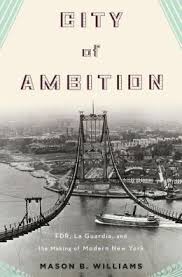City of Ambition – When Folks Could Make It There
Academic history is assiduously researched and tightly argued. Popular history, in contrast, pays homage to those methods with different goals. It aims to surprise and engage. Popular history provokes, and most importantly, it is designed to give the reader pleasure and information.
Mason B. Williams, author of City of Ambition: FDR, LaGuardia, and the Making of Modern New York, understands this well. The key protagonists in his book are well-known and well-researched figures. President Franklin Delano Roosevelt, known for the New Deal and leading the United States through World War II, is perhaps the nation’s most important political leader of the twentieth century. Fiorello LaGuardia, mayor of New York City from 1934 to 1945, is perhaps America’s best known mayor. With multiple biographies on each and multitudes of studies, essays, and books about them, Williams does not aim to captivate us through deeper research and finer detail. Instead, he offers a refreshing take on the two men, their complicated relationship, and its impact on America’s largest city. He has written a very good popular history.
FDR was a wealthy patrician, born to serve in government and lead. LaGuardia was an immigrant’s son who had to scramble to get ahead. Both faced difficult personal crises: FDR struggling with polio, LaGuardia losing his wife and child. Both men fought through political challenges, and both had great spirit, able to inspire and connect with the broader public. FDR was a Democrat. LaGuardia was a Republican. Despite partisan differences, they respected each other and found many ways to coöperate and collaborate.
Williams book works well capturing the human element. Partnerships – and in many ways this was an odd sort of partnership – are shaped by personalities. The substance of this history, though, is the federal government’s investment in the development of modern NYC. Federal dollars provided many jobs and funded the creation of much of the city’s infrastructure. In turn,Williams also makes it clear that the federal government needed effective and flexible local agencies and governments to be effective. Compromise and bipartisan work was at the core of the New Deal in Gotham.
Governance was different then, and in many ways, much stronger. One clear take away from City of Ambition is that we have lost much of bipartisan spirit. It very much was a different time.
David Potash